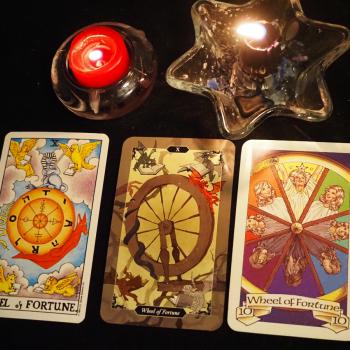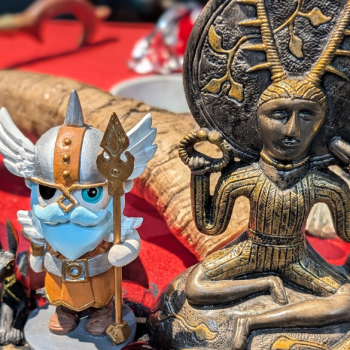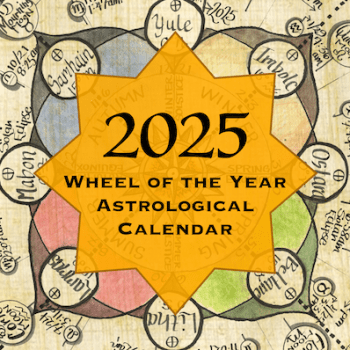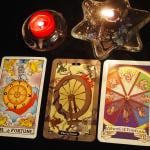______________________________________________________________________________________________________
A Pagan Almanac for July 20, 2012
Lunar Cycle: Second day of the waxing Moon
Athens: Hekatombaion 2, sacred to the Good Spirit
William Blake wrote:
The Harlot’s cry from Street to Street
Shall weave Old England’s winding Sheet.
_____________________________________________________________________________________________________
%%%%%%
After my strange experience in the summer of 1955, I went looking for information about religion. In the tiny branch of the Marin County library in Tamalpais Valley, I found a book called Witches Still Live, published in 1928, by Theda Kenyon. (She was a minor New York literary figure, wrote novels and poetry, taught at Hunter College, contributed one story to Weird Tale, but had no discernable connection to any Witches at that time.) For the most part the book is a hodge¬podge of Frazer and folklore, but it opens with a summary of Leland’s Aradia. This “Gospel of the Witches of Tuscany”—with its talk of naked meetings and free love beneath the full moon, of rebellion against oppressive overlords—was very heady stuff for a repressed teenager in the 1950s. That was the kind of religion I would like to have—if I could ever find it. And the idea that the true divinity was a Goddess! That possibility captivated me. I placed Witchcraft high on my list of Fascinating Topics to Be Investigated As Soon As Possible.
Three years later I found Gerald Gardner’s Witchcraft Today in the San Francisco Public Library. (In those innocent days, books on the occult could be left on open library shelves and yet not be stolen.) I recognized that this was a Witchcraft of the same general type as in the Aradia. I was intrigued by Gardner’s claim that this sort of Witchcraft had survived from the Middle Ages into this century and that he had been initiated into one of the last surviving covens. I took careful notes on all the fragments of information about what was done in rituals that he seemed to let slip in the book.
Now immensely interested in the topic of Witchcraft, I began searching out relevant books. This was not as easy as it sounds: most of the books on “Witchcraft” in libraries in the 1950s were about medieval persecutions and had nothing to do (as far as I could see) with the survival of paganism that Leland and Gardner described. The next important books I was given in 1961. One was Margaret Murray’s God of the Witches, given to me as a prize after a poetry reading; it inspired me to write a lot of (not very good) poetry about Witches. The other was Robert Graves’ The White Goddess, given to me by my classmate, the poet Robert Chrisman; I was enthralled by it, and read through it eight times during the next six years. In 1963 I wrote a Goddess Wedding for my dear friends Larry and Catherine; at the time I did not realize that it marked a turning point in Craft theology.
In the fall of 1967 my friend Sarah asked me to help her write a “Witches’ Sabbath” for a graduate seminar on ritual at San Francisco State. Thus began the work of creating what we came to call the New Reformed Orthodox Order of the Golden Dawn. The name was intended to be mildly funny. The major reason for choosing it was that I was studying Yeats for my Master’s Orals; I knew that Yeats had been the Grand Master of the Stella Matutina, an offshoot of the Hermetic Order of the Golden Dawn; and it seemed obvious that the magic used by the Craft was derived from the HOGD system. The work of creating the NROOGD occupied me and many friends for much of the following decade.
What enabled us to reinvent a very Gardnerian sort of Witchcraft for ourselves was that more and more books about Gardnerian rituals and practices were being published by the late 1960s. Most of these were written by Gardnerians, who accepted all of Gardner’s historical claims as being simple fact. There were other Witches who disputed Gardner’s authority and who claimed to belong to similarly surviving covens, quite independent of Gardner. Until 1979, Doreen Valiente seemed (to Americans) to be one of the most important of these independent Witches. In complete contrast, most of the scholars who touched on Gardner dismissed his claims out of hand and asserted that he must have made the whole thing up, but they did not present any sort of evidence to support this assertion. I had also found Elliott Rose’s A Razor for a Goat in 1965, when I was working at Stanford. I think he may have been the first scholar to look seriously at Gardner’s writings, but it was not a sympathetic look. Rose took a more moderate position about Murray and conceded that Gardner might have had some data from an older coven or covens, but Rose doubted that such data went back past about 1875. Having been able to construct the NROOGD rituals out of fragments of information about Gardnerian practices, I began to wonder if perhaps Gardner had not done much the same thing: constructed his “survival” out of the fragments of data that can be gleaned from Margaret Murray and other sources.
There was one way that Gardner’s claims might be tested. In their books, Doreen Valiente and various writers who were clearly Gardnerian (such as Raymond Buckland and Patricia Crowther) had argued that Gardner had not begun from scratch. They agreed that he had, as he said, augmented the fragmentary traditions of the coven he was initiated into, building them up into a viable system, as recorded in the Book of Shadows, which he then used to found new covens during the 1950s; and that, despite his eclecticism, he was preserving the essential concepts and practices of an ancient religion. Hence by 1971 I was wondering what had constituted the traditions of the older coven into which Gardner said he had been initiated, and what Gardner’s contributions had been. I thought it might be possible, by careful critical analysis, to distinguish Gardner’s additions to the Book of Shadows from the older body of data he was working with. But exactly what might such an analysis be applied to?
The problem here is that the “Book of Shadows” is more a concept than an object. It is supposed to be handcopied by each Witch after she or he has been initiated, and therefore exists—even in this era of xerography—only as a family of manuscript traditions. The situation is exactly analogous to what a person faces in trying to do New or Old Testament textual criticism, since the Bible also survived into modern times in the form of many families of manuscripts whose readings differed in thousands of places. In 1971 I was already beginning the studies that led to my being in graduate school in Berkeley from 1974 to 1980. I knew I could apply the methods of textual and literary scholarship (which were actually invented by the first Neopagans, in Italy during the Renaissance) to Craft writings. But, again, to which Craft writings?
The specific problem was that all the published versions of the Book of Shadows were actually only the versions (and usually rather degenerate ones at that) in specific manuscripts. Some bits and pieces of rituals are included in Gardner’s own books, but they don’t amount to much. Stewart Farrar’s What Witches Do (1971) contains the full text (except for the “Craft Laws”) of the Book of Shadows that Alex Sanders obtained when he was initiated in 1963 by Pat Kopanski (there is a letter in Toronto from her to Gardner that gives the details of Sanders’ initiation; she had been initiated by Patricia Crowther). Furthermore, these published versions had surely been tampered with by the publishers’ editors; so reliable historical conclusions about what materials Gardner had to start with, and what he added, could not be based on these books. Instead, to arrive at dependable conclusions, I would have to work from the original manuscripts themselves. That is, I would have needed access to the “Master” copy of the Book of Shadows and to whatever books or documents Gardner might have had from the older coven. In 1971, I had no idea whether such things existed. If they did, I thought they would probably be the very private and very secret property of a Gardnerian coven somewhere. Even if I could discover their existence, I would probably not be allowed to see them; so I thought my questions would have to remain unanswered.
However, in 1971 I first saw the document usually called the “Craft Laws”; it appeared in June Johns’ King of the Witches: The World of Alex Sanders. The document fascinated me. Internally it purports to have been written in the mid-18th century, and to include materials dating back to the 16th. My intuition was that the document must somehow be the key to Gardner’s historical claims, as has turned out, in an odd way, to be quite correct. Also in 1971 Llewellyn published Lady Sheba’s Book of Shadows; this was the first time that an almost complete copy (it lacked the Third-Degree Elevation) of the Book of Shadows had been published and widely distributed. Lady Sheba claimed to be a pre-Gardnerian Witch, but knew only Gardnerianism and folk magic; it later turned out that she had gotten the BoS from a coven in London.
Her book also began with a text of the Craft Laws. I had been reading Bruce Metzger’s excellent The Text of the New Testament, which explains the principles of textual criticism; so it occurred to me to try comparing the two texts of the Craft Laws in Johns and Sheba. Doing so, I discovered that the texts differed in more that 150 places, often in ways for which no immediate explanation was obvious. I wrote up my conclusions in an essay called “Textual Criticism and the Craft Laws.” (Isaac Bonewits subsequently published it in Gnostica in 1974.) At the time, this exercise led me to suspect there had been an earlier document (or set of documents) from which these two texts had been derived, and I was on the alert for any evidence of its existence.















